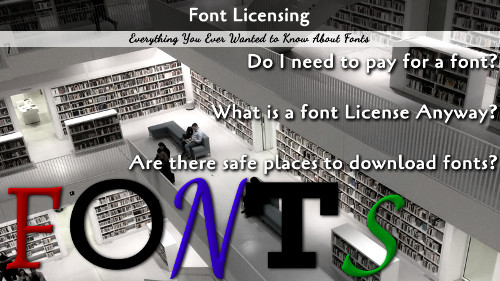This article discusses the factors surrounding font licensing: What it is, why you need it, where to get it. We will cover a resource you can find a lot of fonts for free, and some excellent paid resources for even more options.
If you are writing a book for public distribution, you need to consider the fonts that are being used. A font is licensed software. That means if you use it illegally, you can be sued. Just because the font is on your computer or you found it for free on the Internet, that does not give you the rights to use it in your publication. You need to track down the license for each font and be sure you have the proper permissions for your application.
First, if you are looking to use a font on your computer, the best thing to do is look up the font online. You can check out affiliate, FontSpring, and see what they have. If that doesn't work, crack those knuckles and start doing some searches to find the source and the license. When you do find the license, you will find works like Desktop or eBook. Let's discuss what these mean.
Desktop License
This is the common license you will find for publishers. The Desktop License means you can use the font for any application, commercial or otherwise, as long as the font is not distributed. This mostly means if the font is used in an image, it is legal. The image could be the cover for your book, some interior graphic, or a table. If you have a Desktop License, you are free to use that font in as many projects are you like, and the license covers being used for the text in a printed book.
The limitations for this license are in the number of users. If you are a sole publisher who is just working on your own personal books, you need just one license. If you work in an agency, check the terms of your specific license for the number of users and computers the font can be installed on.
eBook License
This license is needed if your font appears in the text of your book. When you produce an eBook, the fonts are embedded in the file and used on the reader's device. When you purchase this license, you are buying access to a title it can be placed into. This means you can only use it for a single book, no matter how many books are sold.
If the font is only used in an image in the book, you do not need the eBook license, as images are covered in the Desktop License. If you are buying a desktop license, you may be able to add an eBook license for only a small fee more.
Website License
As can be deduced, this is the license you need to publish the font on a website. This means using the font as a style on the page by loading the font in the web browser. These licenses are sold by the page views, so you are buying website visits to your site. The higher the traffic to the site, the more you will pay in licensing fees.
If you only need a few small instances of the font for your website, consider using images instead of font embedding.
Open Source Licenses
There are several open source licenses that allow some or all of these fonts freely. When I need a font, the first place I go is FontSquirrel, which has a lot of fonts with open source licensing. If that fails, I buy them from FontSpring to make sure I am covered.
The most common free licenses you will find are the SIL license (OFL), and the Apache license. Both of these make the font legal to use in any of the applications described herein. You will find other free licenses on FontSquirrel as well, so read the license page of any font you want to use.


